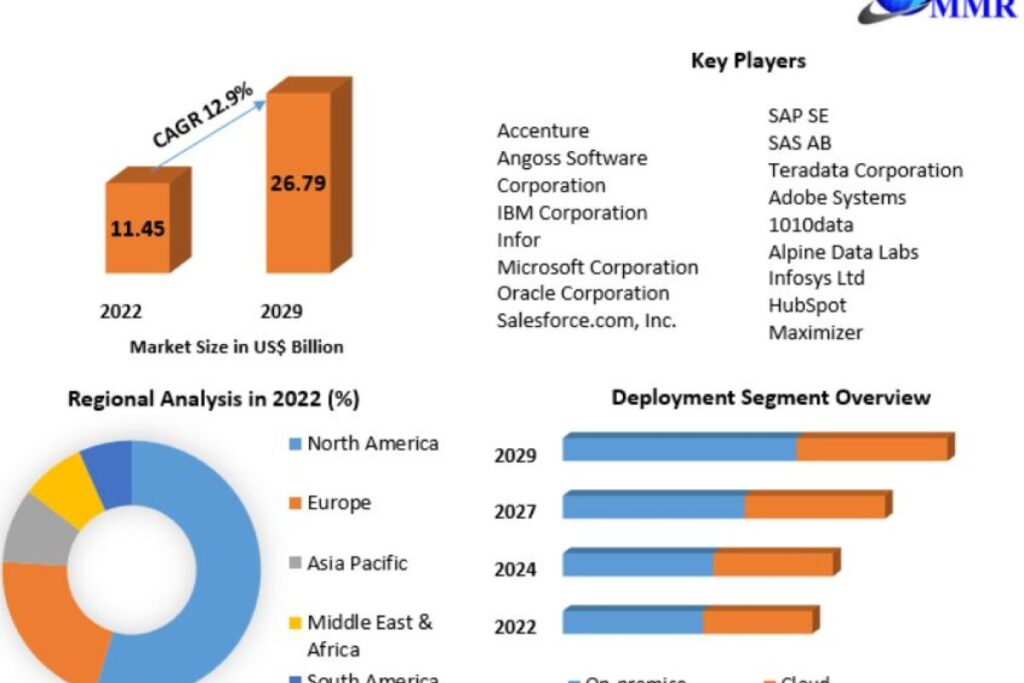Imagine a world where businesses could gain valuable insights into their customers, enhance sales strategies, and make informed business decisions. Well, this world is not just a possibility anymore; it is the reality with CRM Analytics. The CRM Analytics Market is projected to be worth a staggering USD 11.45 billion by 2022, with a constant growth rate of 12.9% in the following years. This market encompasses various types of analytics, such as sales, customer, contact center, marketing, and web & social media analytics. Industries like BFSI, healthcare, retail, telecom and IT, and media and entertainment are leveraging CRM analytics to drive business outcomes. With the demand for personalized decision-making and strategic marketing on the rise, this market shows no signs of slowing down. Keep reading to discover more about this dynamic industry and its key players, including Accenture, IBM Corporation, Salesforce.com, Inc., SAP SE, and Microsoft Corporation. Prepare to be amazed by the possibilities CRM Analytics can offer to your business.

This image is property of whatech.b-cdn.net.
CRM Analytics Market Overview
Welcome to our comprehensive article on the CRM Analytics Market! In this article, we will provide an overview of this market, its size in 2022, projected revenue growth from 2023 to 2029, types of CRM Analytics, industries using CRM Analytics, factors driving the growth of the CRM Analytics Market, expected market share by 2029, the leading end-user segment, dominance of North America in the market, and key players in the CRM Analytics Market.
Let’s dive right in!
Market Size in 2022
The CRM Analytics Market is estimated to be worth USD 11.45 billion in 2022. This significant market value showcases the increasing importance of analytics in customer relationship management. As companies continue to focus on improving customer experience and optimizing their business processes, CRM analytics plays a crucial role in providing valuable insights and actionable data.
Projected Revenue Growth from 2023 to 2029
The CRM Analytics Market is poised for substantial growth in the coming years. Total revenue in this market is projected to increase at a Compound Annual Growth Rate (CAGR) of 12.9% from 2023 to 2029. This impressive growth rate highlights the rising adoption of CRM analytics solutions across industries and the increasing recognition of its benefits in driving business success.
Types of CRM Analytics
CRM analytics encompasses various types of analytics that help businesses make data-driven decisions and enhance their customer relationship management processes. The key types of CRM Analytics include:
1. Sales Analytics
Sales Analytics focuses on analyzing sales data to identify trends, forecast sales performance, and optimize sales strategies. By leveraging sales analytics, businesses can gain valuable insights into customer behavior, sales rep performance, and deal pipeline to drive revenue growth.
2. Customer Analytics
Customer Analytics involves analyzing customer data to gain insights into customer behavior, preferences, and needs. By understanding their customers better, businesses can personalize interactions, improve customer satisfaction, and enhance customer loyalty.
3. Contact Center Analytics
Contact Center Analytics focuses on analyzing data from customer interactions at contact centers. This type of analytics helps businesses improve the efficiency of their customer service operations, identify areas for improvement, and enhance the overall customer experience.
4. Marketing Analytics
Marketing Analytics involves analyzing marketing data to measure the effectiveness of marketing campaigns, identify customer segments, and optimize marketing strategies. By leveraging marketing analytics, businesses can make data-driven decisions to target the right audience, improve marketing ROI, and drive customer engagement.
5. Web & Social Media Analytics
Web & Social Media Analytics focuses on analyzing data from websites and social media platforms to understand customer behavior, monitor brand perception, and measure the impact of digital marketing efforts. This type of analytics enables businesses to make informed decisions to optimize their online presence and engage with their target audience effectively.
Industries Using CRM Analytics
CRM analytics is widely adopted across various industries to drive business outcomes and enhance customer relationships. The key industries using CRM analytics include:
1. BFSI (Banking, Financial Services, and Insurance)
The BFSI sector leverages CRM analytics to gain insights into customer behavior, improve cross-selling and upselling opportunities, and enhance customer satisfaction. By analyzing customer data, financial institutions can tailor their offerings to meet individual needs, detect fraud, and proactively address customer concerns.
2. Healthcare
In the healthcare industry, CRM analytics plays a crucial role in improving patient engagement, optimizing healthcare marketing campaigns, and enhancing the quality of care. By analyzing patient data, healthcare providers can personalize patient experiences, improve patient outcomes, and optimize resource allocation.
3. Retail
The retail sector extensively uses CRM analytics to understand customer preferences, optimize pricing strategies, and enhance inventory management. By analyzing customer data, retailers can create personalized shopping experiences, drive customer loyalty, and boost sales.
4. Telecom and IT
Telecom and IT companies leverage CRM analytics to analyze customer data, improve customer service, and optimize marketing strategies. By understanding customer behavior and preferences, telecom and IT firms can enhance customer retention, increase upsell and cross-sell opportunities, and drive revenue growth.
5. Media and Entertainment
CRM analytics is also widely used in the media and entertainment industry to understand audience preferences, personalize content recommendations, and optimize marketing efforts. By analyzing viewer data, media and entertainment companies can deliver targeted content, increase viewer engagement, and drive subscriptions.
Factors Driving the Growth of CRM Analytics Market
The growth of the CRM Analytics Market is driven by various factors that emphasize the importance of data-driven decision-making and marketing strategies. The key factors driving market growth include:
1. Demand for Personalized Business Decisions
In today’s competitive landscape, businesses need to personalize their offerings and marketing efforts to meet the ever-changing customer needs and preferences. CRM analytics provides valuable insights into customer behavior, enabling businesses to make data-driven decisions and deliver personalized experiences. The increasing demand for personalized business decisions is fueling the adoption of CRM analytics solutions.
2. Strategic Marketing Initiatives
Effective marketing is crucial for businesses to drive customer acquisition, engagement, and loyalty. CRM analytics enables businesses to measure the effectiveness of marketing campaigns, identify customer segments, and optimize marketing strategies. By leveraging CRM analytics, businesses can make informed decisions to target the right audience, improve marketing ROI, and drive business growth.
Expected Market Share by 2029
Among the various types of CRM Analytics, Marketing Analytics is expected to have the largest market share by 2029. With the growing importance of data-driven marketing strategies and the increasing focus on customer engagement, businesses are investing in marketing analytics solutions to optimize their marketing efforts, measure campaign performance, and enhance customer interactions.
Leading End-User Segment
In the CRM Analytics Market, the retail sector is anticipated to be the leading end-user segment. Retailers rely on CRM analytics to understand customer preferences, optimize pricing strategies, and enhance inventory management. By leveraging CRM analytics, retailers can create personalized shopping experiences, drive customer loyalty, and achieve business success.
Dominance of North America in the Market
North America dominates the global CRM Analytics Market due to several factors. One key factor is the advanced data collection capabilities and infrastructure in the region. With a strong emphasis on data privacy and security, North American businesses have invested in robust customer data management systems, enabling them to collect and analyze vast amounts of customer data. Additionally, North American companies have a deep understanding of customer needs and recognize the importance of leveraging CRM analytics to drive business success.
Key Players in the CRM Analytics Market
The CRM Analytics Market is highly competitive, and several key players are driving its growth. Some of the prominent players in the market include Accenture, IBM Corporation, Salesforce.com, Inc., SAP SE, and Microsoft Corporation. These companies offer innovative CRM analytics solutions, helping businesses optimize their customer relationship management processes and drive business outcomes.
In conclusion, the CRM Analytics Market is experiencing significant growth, driven by the increasing demand for personalized business decisions and strategic marketing initiatives. With various types of CRM analytics, industries across BFSI, healthcare, retail, telecom and IT, and media and entertainment are leveraging CRM analytics to enhance customer relationships and drive business success. The dominance of North America in the market, along with the presence of key players, demonstrates the growing importance of CRM analytics in today’s data-driven business landscape.
